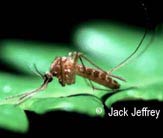West Nile Virus

The West Nile virus appears to be firmly established in the United States, and researchers expect its continued spread and entrenchment in wildlife populations. Since 1999, WNV has been detected in humans, horses, birds, or mosquitoes in 47 states and the District of Columbia. Only Hawai'i, Alaska, and Oregon have yet to report any detection of WNV in human, equine, bird, or mosquito populations. According to the U.S. Centers for Disease Control and Prevention, 4156 people in the the U.S. tested positive for the West Nile Virus in 2002, and 284 people died of the virus. Many more people were likely to have been infected with the virus, but experienced mild or no symptoms, and were never tested. As of 13 November 2003, the CDC has received confirmation from state agencies of 8219 human cases of West Nile Virus for the year, resulting in 182 deaths. Statistically, a person's risk of contracting West Nile is low. In most areas where the virus is established, only 1% of the area's mosquitoes carry the virus. Less than 1% of people bitten by these infected mosquitoes develop serious complications from the virus; the remainder exhibit flu-like symptoms, or no symptoms at all. Those at highest risk are the elderly and people with weakened immune systems; it is important, however, for all people to protect themselves from mosquito bites to minimize the risk of infection. |
|
Culex pipiens photo © Jack Jeffrey. Used with permission.
Current Biological Issues
Biodiversity |
Biology in the News |
Bird Conservation |
Coral Reefs
Frogweb: Amphibian Declines & Malformations |
Invasive Species |
Pollinator Declines
West Nile Virus |
Wildlife Disease
This NBII site is developed and maintained by the
National Wildlife Health Center of the U.S. Geological
Survey
![]()
NBII Disclaimer and Privacy Statement | Accessibility

